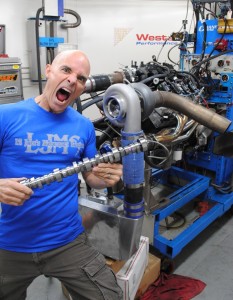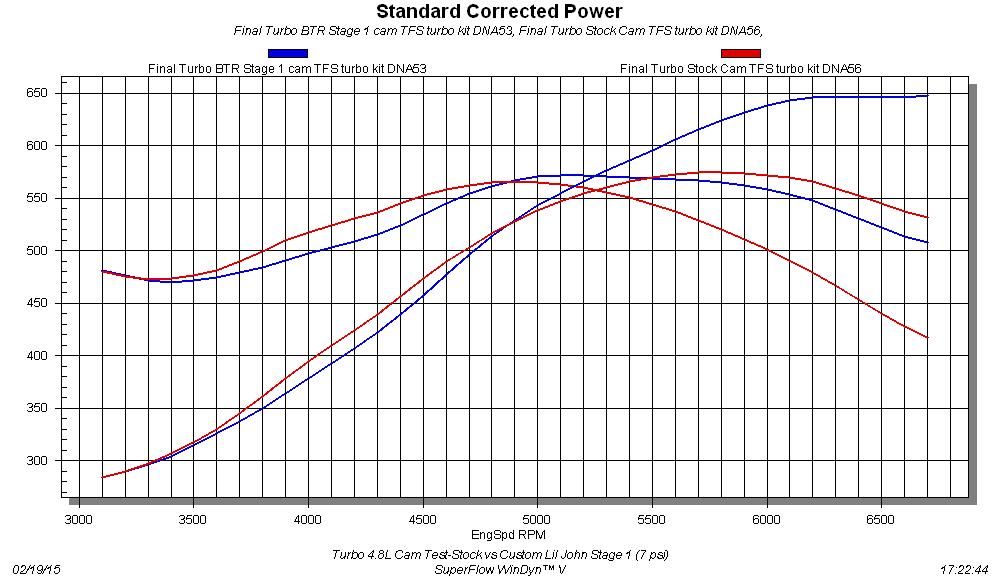By Richard Holdener
By now Chevy enthusiasts should be well aware of the fact that the single best performance modification for any LS motor is a cam swap. Unlike the previous generation of small blocks, the LS was factory equipped with plenty of head flow and a powerful intake manifold. With displacement and compression, the only thing restricting the output of an LS motor is the mild factory cam timing. Add a cam to just about any LS motor and watch the power soar. The question now is, as effective as cam swaps are on a normally aspirated LS motor, is a bumpstick the hot set up once you add boost? After all, aren’t boosted motors supposed to run mild cams to eliminate overlap? In fact, much of the information you read on turbo and supercharged motors recommend simply running the stock cam profile. Well folks, we are here to show you that even when you add a turbo to the mix, LS motors still respond amazingly well to performance cam swaps. The only difference is that the turbo application will respond best to a dedicated turbo cam.
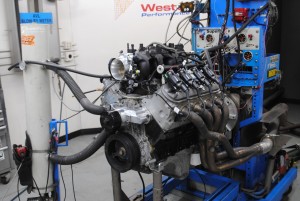
The test motor started out life as a high-mileage 4.8L LR4. The motor was bored .010 over, honed, and decked to make way for some minor upgrades.
To illustrate the power gains offered by a cam swap on a turbo application, we needed two things: a dedicated turbo cam, and a suitable turbo ready LS to test it on. Our turbo cam came from the turbo LS experts at Lil John’s Motorsport Solutions. Since we would be testing the Lil John’s stick on a 4.8L, we decided to try the Stage 1 grind. Mildest of the Lil John’s offerings for turbo applications (though they are currently testing milder grinds designed for 4.8L applications), the Stage 1 cam (ground by COMP Cams) offered a .601/.598 lift split, a 222/227-degree duration split and 113-degree LSA. Mild for most LS applications, even the Stage 1 was a healthy cam on the tiny 4.8L. The motor for our turbo cam test started out life as a high-mileage 4.8L plucked from a local wrecking yard. After a quick bore and hone, the LR4 was treated to a fresh set of rings and bearings along with a forged piston upgrade that included a set of JE pistons from their SRP Professional-series. Each .010-over slug featured a 7cc dome to add some much needed static compression to the little 4.8L.
Though the 4.8L could get by with a set of stock 706 heads, we decided to treat the turbo test mule to a cylinder head upgrade. The small 3.78-inch bore employed on the 4.8L (and 5.3L) required a suitable cylinder head. What the small-displacement 4.8L needed was cylinder heads that maximized flow while minimizing port volume. The heads in question would also need to have the proper combustion chamber volume to work with the small-bore motor. The ideal heads for our turbo motor came from TFS in the form of their CNC-ported Gen X 205s. The Gen X 205s offered a number of desirable features, including altered valve angles (from 15-13.5 degrees) to improve flow, increased structure below the rocker pedestals to improve valve-train stability, and relocated spark plug holes to further enhance mid-lift flow. The Gen X 205 heads also featured 58cc combustion chambers designed for the small-bore LS applications, a 2.0/1.575 valve package, and a dual valve spring package capable of supporting our .600-lift, Stage-1 cam. According to the flow data supplied by TFS, the 205-cc intake ports flowed 284 cfm, or enough to support over 550 normally aspirated horsepower. The Gen X 205 heads were installed using a set of Fel Pro MLS head gaskets and ARP head studs.
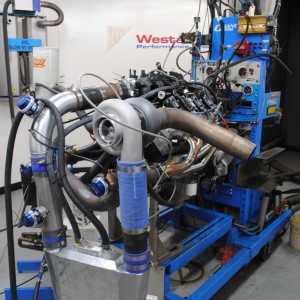
Despite keeping the test pressure down to just 7 psi, we opted to include this air-to-water intercooler from CX Racing. The intercooler was fed ambient dyno water, though ice water would up the power ante.
To test a turbo cam, we obviously needed a turbo system. Rather than use a complete turbo kit, we assembled one for dyno use. The major components of the kit included a set of tubular exhaust manifolds and a GT45-style turbo from DNA Motoring. These were combined with an air-to-water intercooler from CX Racing, a pair of 45mm Hypergate wastegates, and a Blow-Off valve (BOV) from Turbosmart. The stainless steel DNA exhaust manifolds featured V-band clamps that we used to connect our custom Y pipe. The Y-pipe featured a T4 turbo flange, the necessary V-band flanges and provisions for the dual wastegates. The manifolds exited forward toward the front of the motor and the Y pipe channeled the exhaust from both sides to feed the turbo. Exhaust exited through a 3.5-inch exhaust pipe, while boost was fed from the compressor to the 3.5-inch inlet into the air-to-water intercooler. Exiting the cooler, the chilled charge air was fed to the Accufab throttle body on the stock truck manifold. Fuel for the turbo motor was supplied by a set of Holley 83-pound injectors and controlled by a Holley Dominator EFI system. The waste gates were configured with 7 psi springs and no wastegate controller was used for this testing.
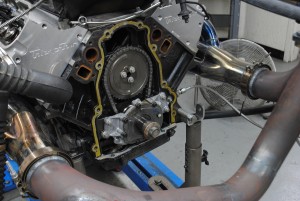
After establishing our baseline with the stock cam, it was time for an upgrade. Lil John’s supplied this Stage 1 turbo cam (ground by COMP Cams) that offered a .601/.598 lift split, a 222/227-degree duration split, and 113-degree LSA.
To properly test the merits of the Lil John’s turbo cam, we first needed to run the 4.8L with the stock cam at 7 psi then again after performing a cam swap. The 4.8L was installed on the dyno and configured with the homemade turbo system. After tuning the combination, we were able to run the turbo motor with the Turbosmart wastegates keeping a consistent and repeatable 7 psi with the stock cam. The turbo 4.8L produced peak numbers of 574 hp at 5,800 rpm and 566 lb-ft of torque at 4,900 rpm. Despite the limited displacement, this turbo 4.8L pumped out power like a big block. Torque production exceeded 550 lb-ft for nearly a 900-rpm spread, from 4,500 rpm to 5,400 rpm. The turbo LR4 exceeded 500 lb-ft from 3,800 rpm to 6,000 rpm, making for one sweet torque curve, but now it was time to see what a dedicated turbo cam had to offer.
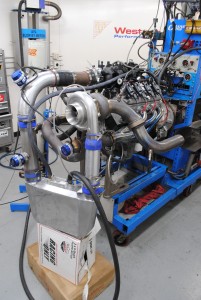
Equipped with the Stage 1 cam, the turbo 4.8L now produced 648 hp and 572 lb-ft of torque. Measured peak to peak, the turbo cam increased the power output of the little 4.8L by almost 75 horsepower, but the gains exceeded 110 hp at 6,600 rpm.
Out came the stock cam and in went the stick from Lil John’s. Even with a turbo, a cam swap on the LS was quick and easy. Once the new cam was in place, we dialed in the air/fuel mixture to 11.8:1 and kept the total ignition timing at 24 degrees (running 100 octane). Keeping the air/fuel, timing, and boost level the same between tests is a critical step to ensure accurate data. One thing that became immediately apparent was that the new cam would push peak power much higher in the rev range. Where the stock cam made peak power at 5,800 rpm, the Stage 1 cam pushed things to 6,700 rpm. The new combo produced peak numbers of 648 hp at 6,700 rpm and 572 lb-ft of torque at 5,200 rpm. The new combination not only increased the power output by nearly 75 hp, but sounded amazing doing so. The power gains exceeded 110 hp at 6,700 rpm. The combination of turbo power and the extra rpm made this little motor sound considerably bigger. We knew things were going well when the owner of the 900 horsepower big block testing in the next dyno cell came over to tell us how wicked the little turbo motor sounded. He was amazed at the combination of displacement, power output, and boost level. When it comes to LS motors, I guess boost and bump sticks go hand in hand.
Just as it does on a normally aspirated LS motor, the right cam can make all the difference in the world on a turbo application. Case in point, this modified 4.8L LR4 that featured a short block equipped with JE forged pistons, topped with a set of CNC-ported, TFS Gen X 205 heads. Run with the stock cam and a single GT45-style turbo from DNA Motoring, the turbo 4.8L produced 574 hp at 5,800 rpm and 566 lb-ft of torque at 4,900 rpm at a peak boost level of 7 psi. After swapping in the Stage 1 cam from Lil John’s, the peak power jumped to 648 hp at 6,700 rpm and 572 lb-ft of torque at 5,200 rpm. Out past 6,500 rpm, the dedicated turbo cam was worth over 100 hp on this mild 4.8 liter!
Sources
Aeromotive
aeromotiveinc.com
COMP Cams
compcams.com
CXRacing
cxracing.com
DNA Motoring
dnamotoring.com
Holley
holley.com
JE Pistons
jepistons.com
Lil John’s Motorsport Solutions
liljohnsmotorsports.com
Lucas Oil
lucasoil.com
Trick Flow Specialties
trickflow.com
Turbosmart USA
turbosmartusa.com


